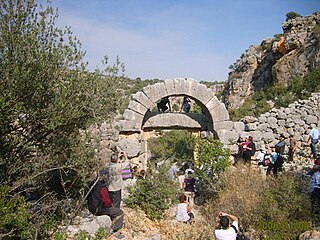Related Research Articles
Orokenda was a town in ancient Pamphylia, inhabited during Roman times. Its name does not occur in ancient authors, but is inferred by epigraphic and other evidence.
Aunesis was a coastal town of ancient Pamphylia or of Cilicia, inhabited during Roman times. It was the port of Hamaxia.
Hamaxia was a town in the east of ancient Pamphylia or in the west of Cilicia. It had a good roadstead for ships, and excellent cedars for ship-building. Hamaxia is likely the same place as Anaxion or Anaxium or Amaxian (Ἁμαξίαν) mentioned by the Stadiasmus Maris Magni as being west of Coracesium. Strabo reports that the town was one of the gifts of Mark Antony to Cleopatra.
Augai or Augae was a coastal town of ancient Pamphylia or of Cilicia, inhabited during Roman times. It was located 70 stadia from Aunesis.
Ptolemais was a coastal town of ancient Pamphylia or of Cilicia, inhabited during Hellenistic times. It was located between the Melas River and Coracesium.
Pisarissos was a town of ancient Pamphylia or of Cilicia, inhabited during Roman times. Its name does not occur in ancient authors, but is inferred by epigraphic and other evidence.
Manava was a town of ancient Pamphylia, inhabited during Byzantine times.
Kalelibelen was a town in ancient Pamphylia.
Pisurgia or Pisourgia was a town on the coast of ancient Cilicia, between Celenderis and Seleucia ad Calycadnum, 45 stadia to the west of Cape Crauni, and to the right of the island of Crambusa.
Kiphisos was a town on the coast of ancient Cilicia, inhabited during Roman and Byzantine times.
Pseudokorasion was a town of ancient Cilicia, on the coast a little to the east of Seleucia ad Calycadnum, inhabited during the Hellenistic, Roman and Byzantine eras.

Korasion, also called Kalon Korakesion, was a town of ancient Cilicia, on the coast a little to the east of Seleucia ad Calycadnum, inhabited during the Roman and Byzantine eras.
Kalanthia was a coastal town of ancient Cilicia, inhabited during the Roman and Byzantine eras.
Herpha, also known as Erpha and Herpa and Erpa, was a town of ancient Cappadocia, inhabited during Hellenistic, Roman, and Byzantine times.
Lauzadus or Lauzadeai was a town of ancient Cilicia or of Isauria, inhabited in Byzantine times. It became a bishopric; no longer the seat of a residential bishop, it remains a titular see of the Roman Catholic Church.
Sbida or Sbide was a town of ancient Cilicia and in the later Roman province of Isauria, inhabited in Roman and Byzantine times. It became a bishopric; no longer the seat of a residential bishop, it remains a titular see of the Roman Catholic Church.
Musbanda or Mousbanda, also called Mousbada, was a town of ancient Cilicia and later of Isauria, inhabited in Roman and Byzantine times. It became a bishopric; no longer the seat of a residential bishop, it remains a titular see of the Roman Catholic Church.
Ano Kotradis was a town of ancient Cilicia, inhabited in Roman and Byzantine times.
Syderos was a town of ancient Pontus, inhabited during Roman and Byzantine times.
Pedachtoë or Pedachthoe, also known as Heracleopolis or Herakleioupolis, was a town of ancient Pontus, inhabited during Roman and Byzantine times. It was assigned to the late Roman province of Armenia Prima, in which it became the seat of an archbishop. No longer a residential see, it remains a titular see of the Roman Catholic Church.
References
- 1 2 Richard Talbert, ed. (2000). Barrington Atlas of the Greek and Roman World . Princeton University Press. p. 65, and directory notes accompanying. ISBN 978-0-691-03169-9.
- ↑ Lund University. Digital Atlas of the Roman Empire.
36°51′45″N31°06′10″E / 36.862538°N 31.102713°E